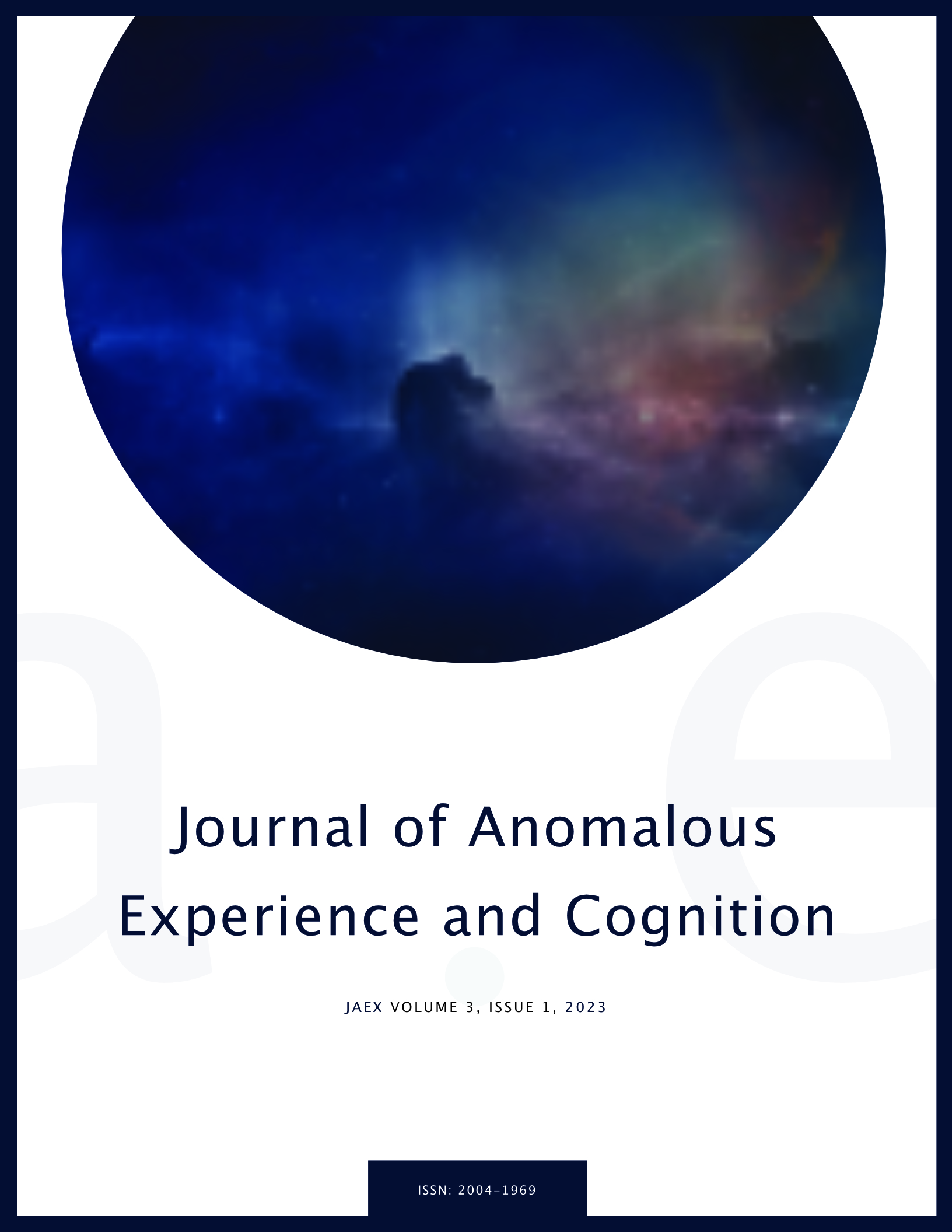The Presentiment Effect Points to an Occurrence of a von Neumann's Collapse
DOI:
https://doi.org/10.31156/jaex.24455Keywords:
tendencies, collapse, actual past, effective past, decoherent histories, consciousness, presentiment, predictive anticipatory activities, physics, von NeumannAbstract
Although small and embedded in strong noise, the surprisingly confirmed presentiment effect is deemed among the more reliable "psi" effects, although such an effect cannot reflect prediction in real-time. Rather, the effect reflects correlations found only in the historical past as a result of the end conditions represented by the participant's psychological responses to the stimuli. That is, the effect does appear, but in retrospect only. The current paper mathematically explains this suggestion through an orthodox interpretation of quantum mechanics whose ontology is outlined. The explanation is based on von Neumann's idea that the system's quantum state collapses when the participant's mind perceives an observation. The argument takes decoherence considerations into account. The presentiment effect's existence and its presented reasonable quantum explanation seem to support von Neumann's idea.
References
American Institute of Physics (2022). https://history.aip.org/exhibits/einstein/ae63.htm
Alvarez, F. (2016). An experiment on precognition with planarian worms. Journal of Scientific Exploration, 30(2), 217-226.
Ananthaswamy, A. (2018). What does quantum theory actually tell us about reality? Scientific American – Observations, September 29. https://blogs.scientificamerican.com/observations/what-does-quantum-theory-actually-tell-us-about-reality/
Bartoloni, R. (2002). Tuscany excalibur? Archaeology Archive, 55. https://archive.archaeology.org/0201/newsbriefs/sword.html
Born, M. (1926). Zur quantenmechanik der stoßvorgänge [On the quantum mechanics of collisions]. Zeitschrift für Physik, 37, 863-867. https://doi.org/10.1007/BF01397477
Carroll, R. (2001). Tuscany’s excalibur is the real thing, say scientists. The Guardian. https://www.theguardian.com/world/2001/sep/16/rorycarroll.theobserver
Di Biagio, A., & Rovelli, C. (2021). Stable facts, relative facts. Foundations of Physics, 51(30). https://doi.org/10.1007/s10701-021-00429-w
Duggan, M., & Tressoldi, P. E. (2018). Predictive physiological anticipatory activity preceding seemingly unpredictable stimulus: An update of Mossbridge et al's meta-analysis. F1000Research, 7:407. https://doi.org/10.12688/f1000research.14330.2
Duma, G. M., Mento, G., Manari, T., Martinelli, M., & Tressoldi, P. (2017). Driving with intuition: A preregistered study about the EEG anticipation of simulated random car accidents. PLos One, 12(1): e0170370. https://doi.org/10.1371/journal.pone.0170370
Esfeld, M. (1999). Essay review Wigner’s view of physical reality. Studies in History and Philosophy of Modern Physics, 30B, 145-154. https://doi.org/10.1016/S1355-2198(98)00031-8
Gell-Mann, M., & Hartle J. B. (1989). Quantum mechanics in the light of quantum cosmology. Proceedings of the 3rd International Symposium on The Foundations of Quantum Mechanics in the Light of New Technology, Tokyo, Japan. https://doi.org/10.1142/9789812819895_0036
Griffiths, R. B. (2002). Consistent quantum theory. Cambridge University Press. http://quantum.phys.cmu.edu/CQT/
Joos, E., Zeh, H. D., Kiefer, C., Giulini, D. J. W., Kupsch, J., & Stamatesch, I.-O. (2003). Decoherence and the appearance of a classical world in quantum theory. Springer. https://doi.org/10.1007/978-3-662-05328-7
Kastrup, B., Stapp, H. P., & Kafatos, M. C. (2018). Coming to grips with the implications of quantum mechanics. Scientific American – Observations. https://blogs.scientificamerican.com/observations/coming-to-grips-with-the-implications-of-quantum-mechanics/
Levin, E. Y. (2020). The presentiment effect as a quantum delusion. Psychology of Consciousness: Theory, Research, and Practice, 7(2), 189–205. https://doi.org/10.1037/cns0000207
Mossbridge, J. A., & Radin, D. (2018). Precognition as a form of prospection: A review of the evidence. Psychology of Consciousness: Theory, Research, and Practice 5(1), 78-93. https://doi.org/10.1037/cns0000121
Passon, O. (2019). On the interpretation of Feynman diagrams, or, did the LHC experiments observe H → γγ? European Journal for Philosophy of Science, 9(2), 20. https://doi.org/10.1007/s13194-018-0245-1
Passon, O., Zügge, T., & Grebe-Ellis, J. (2019). Pitfalls in the teaching of elementary particle physics. Physics Education, 54 (2019), 015014. https://doi.org/10.1088/1361-6552/aadbc7
Radin, D. I. (2004). Electrodermal presentiments of future emotions. Journal of Scientific Exploration 18(2), 253-273.
Radin D. I. (2011) Predicting the unpredictable: 75 years of experimental evidence. Quantum Retrocausation: Theory and Experiment, AIP Conference Proceedings 1408, 204-217. https://doi.org/10.1063/1.3663725
Radin, D. (2016). Presentiment. Psi Encyclopedia. The Society for Psychical Research. from https://psi-encyclopedia.spr.ac.uk/articles/presentiment.
Schiff, L. I. (1968). Quantum mechanics. (3rd ed.), McGraw-Hill.
Stapp, H. P. (1994). Theoretical model of a purported empirical violation of the predictions of quantum theory. Physical Review A50, 18-22. https://doi.org/10.1103/PhysRevA.50.18
Stapp, H. P. (2017a). Retrocausation in quantum mechanics and the effects of minds on the creation of physical reality (and appendices therein). AIP Conference Proceedings 1841, 040001; http://doi.org/10.1063/1.4982777
Stapp, H. P. (2017b). On the nature of things: Human presence in the world of atoms. Springer-Verlag. https://sites.google.com/a/lbl.gov/stappfiles
Tressoldi, P., & Facco, E. (2022). Why consciousness is primary: epistemological and scientific evidence. https://doi.org/10.31231/osf.io/2nwb6
von Neumann, J. (1932). Mathematische grundlagen der quantenmechanik. Springer Heidelberg. Translated (1955) as Mathematical foundations of quantum mechanics. Princeton University Press. Chapter 6.
Wallace, D. (2019). What is orthodox quantum mechanics? In A. Cordero (Ed.) Philosophers look at quantum mechanics. Springer Verlag. 285-312. https://doi.org/10.1007/978-3-030-15659-6_17
Weinberg, S. (1995). The quantum theory of fields – Volume I: Foundations. Cambridge University Press. https://doi.org/10.1017/CBO9781139644167
Wheeler, J. A. (1981). Law without law. In J. A. Wheeler and W. H. Zurek (Eds.) Quantum theory and measurement (pp. 188-189). Princeton University Press.
Wigner, E. P. (1967). Remarks on the mind-body question. In Symmetries and Reflections. Indiana University Press.
Zurek, W. H. (1991). Decoherence and the transition from quantum to classical. Physics Today, 44(10), 36-44. https://doi.org/10.1063/1.881293
Zurek, W. H. (2003). Decoherence, einselection, and the quantum origins of the classical. Reviews of Modern Physics 75, 715-775. https://doi.org/10.1103/RevModPhys.75.715
Downloads
Published
How to Cite
Issue
Section
License
Copyright (c) 2023 Ephraim Yeruham Levin

This work is licensed under a Creative Commons Attribution 4.0 International License.
All articles published in JAEX are open access, freely and universally accessible online, and archived in the open journal’s Lund University website (https://journals.lub.lu.se). Articles in JAEX can be distributed under the terms of the Creative Commons Attribution 4.0 International License CCBY (http://creativecommons.org/licenses/by/4.0/), which permits unrestricted use, distribution, and reproduction in any medium, with appropriate credit to the original author(s) and the source, a link to the Creative Commons license, and an indication if changes were made.



